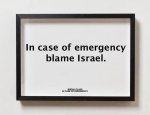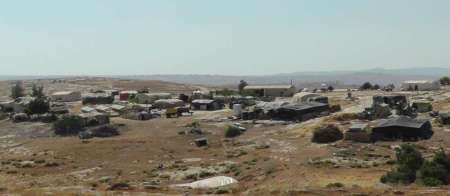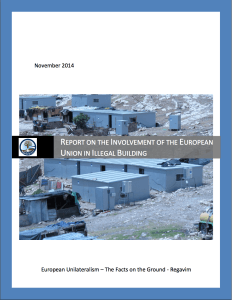Susya - Land-Grabbing By EU Backing
 The huge ongoing campaign against the demolition of buildings [mostly tents] constructed against a court order in Susya village has been successful backed now by some NGOs, US, EU and UN. From Western mainstream media one easily can get picture that Israel plans to destroy ancient Arab village in occupied territory and grabbing land owned by local villagers. The true picture is a bit different, even opposite.
The huge ongoing campaign against the demolition of buildings [mostly tents] constructed against a court order in Susya village has been successful backed now by some NGOs, US, EU and UN. From Western mainstream media one easily can get picture that Israel plans to destroy ancient Arab village in occupied territory and grabbing land owned by local villagers. The true picture is a bit different, even opposite. The question is not only some tents in Susya, besides media war the campaign is part of wider plan – known as "Fayyad Plan", to occupy land for fictional Palestine state from Israel - land which is under direct Israeli control according the “Oslo Accords,” that incorporates within its terms UN Security Council Resolution 242 (1967), which set the basic terms for comprehensive peace in the area. The case also shows an excellent example about the hypocrisy of European Union which same time plans sanctions against Israel due illegal Israeli settlements while continuously financing illegal Arab settlements.
Susya vs. Fake Susya
European Union-American acceptance of the lie of "Arab Susiya" is both a result from a successful PR campaign and against the reality. The archaeological evidence clearly proves that Jews lived in Biblical and Talmudic times until as late as the 9th century in Susya, while academic researchers have categorically established that Arabs never lived there. Modern are aerial photographs decades ago show that not one Arab lived in Susiya, for centuries, only a few thousand Arabs populated the relatively vast southern Hebron Hills and other Arabs came from the Hebron area to stay in caves for two months during the season for planting and reaping wheat or to grave sheep and goats; other than that, Arabs were never to be seen because their homes were elsewhere. All of that changed soon after the early 1980s when the Jews returned after 1,500 years. The focus of the creation of this lie has been Susiya, the largest Jewish community in the area, although less than 200 families live there. It is located several hundred yards from the Talmudic city, which is protected as a natural park. The European Union – i.a. - have invested tens of thousands of dollars to bring Arabs to the narrow stretch of land separating modern and ancient Susiya. Local resident Karni Eldad describes this side of settlement activities in i24news as follows:
Below short video about the real ancient history and origins of Susya: And below the Illegal Palestinian Settlement - fictional Arab village - of Susya:Everybody knows that the settlements beyond the Green Line receive extensive subsidies and incentives. For example, a small community south of Hebron receives wind turbines to produce free electricity, it gets free mobile homes, free air conditioners, free toilets, free water tanks, a free library, free agricultural sheds, a free mobile clinic and free health care, and even basic food items, completely for free. Oh yeah, and a free mosque. Why a mosque? Because this settlement is an illegal Palestinian outpost, established in Israeli territory (Area C according to the Oslo Accord’s territorial division), and is located near the Jewish settlement of Susya in the southern Hebron hills. Who finances it? The EU, of course.
 Earlier about Susya case in Demolition of Susya Settlement as a Result Unsolved Israeli-Palestinian Conflict
Earlier about Susya case in Demolition of Susya Settlement as a Result Unsolved Israeli-Palestinian Conflict
Susya as part of "Fayyad Plan"
After the signing of the Oslo Accord in 1993, and especially since 2009, Palestinians began to establish outposts in Area C with massive European funding. These outposts are designed to interrupt the continuity of Jewish settlement in Judea and Samaria. This program is called the "Fayyad Plan", named after Salam Fayyad, the Palestinian official who conceived it. The Europeans, for their part, are joining the initiative as they consider Judea and Samaria occupied territory and are working to establish a Palestinian state in the entire territory. The so-called “Fayyad Plan” entitled “Ending the Occupation, Establishing the State,” is breathlessly ambitious. Fayyad, a US-educated economist and former senior World Bank official, challenged the Palestinian policy of liberation through armed struggle by proposing peaceful, proactive development. The plan had and still has US and EU support and has got aid in the billions. Also Israel has backed Palestinian economic development and reform from bottom up to establish a demilitarised state.
 The Fayyad Plan includes 3 major pillars – 1. Structural reform of the central and local government administration. 2. Restoring and re-establishing the security system (Palestinian Police, courts, prisons, etc.). 3. Building the economic and physical infrastructure in all areas, (banks, public and educational facilities, electricity, water, sewage and roads etc.) whilst focusing on Area C.
In her analysis about "Fayyad Plan", The Fayyad Plan: Implications for the State of Israel , Natalia Simanovsky describes the benefits of plan as follows:
The Fayyad Plan includes 3 major pillars – 1. Structural reform of the central and local government administration. 2. Restoring and re-establishing the security system (Palestinian Police, courts, prisons, etc.). 3. Building the economic and physical infrastructure in all areas, (banks, public and educational facilities, electricity, water, sewage and roads etc.) whilst focusing on Area C.
In her analysis about "Fayyad Plan", The Fayyad Plan: Implications for the State of Israel , Natalia Simanovsky describes the benefits of plan as follows:
However the “Fayyad Plan leaves a number of issues unresolved, such as Jerusalem, the right of return, borders, the Jewish settlements in the West Bank and, lastly, Gaza. The essence of the Fayyad plan was to build the apparatus of a Palestinian state within two years, regardless of progress in the stalled peace negotiations with Israel. Israeli officials reacted with consternation over what they saw as a unilateral action even Fayyad has rejected calls for a binational state and unilateral declaration of statehood. The core negative aspect of the plan is, in my opinion, that it Fayyad calls for massive Palestinian development in Area C – an area in which is under direct Israeli control - the Palestinian Authority exercises civil powers and responsibilities as well as functional jurisdiction under the umbrella of overall Israeli security and civil administration – the fate of which is intended by the Interim Agreement to be negotiated in the permanent status negotiations. See more at: Palestine Ending the Occupation, Establishing the State (Fayyad Plan)
In evaluating the successes of the Fayyad plan, addressing its obstacles and Israeli misapprehensions, this paper argues that the creation of an independent Palestinian state will work towards Israel’s advantage for the following reasons: First, it guarantees the two-state solution, ensuring that the State of Israel remains Jewish and democratic. Second, Israel’s responsibility towards the Palestinians will be dramatically reduced, for a Palestinian state would become responsible for its own citizens, territory and borders. Third, an independent Palestine will improve Israel’s serious legitimacy problem, for the relationship will be that of two sovereign states, as opposed to the current asymmetrical relationship between a state and a non-state. Fourth, a Palestinian state will strengthen the hand of the moderates, namely Fateh and Fayyad, while weakening the terrorist organization Hamas and other Islamic radicals. Finally, the environment for peace negotiations will improve, as Israel’s security needs will be met and the Palestinians, having achieved their decades-long desire for self-determination, will be negotiating from a place of pride and accomplishment, as opposed to the hopelessness and humiliation that engulfs them on a daily basis.
Quiet annexation with help of EU hypocrisy
“Aid to the Bedouin” is a political program of the Palestinian Authority that was in conjunction with the previous PM Salam Fayyad, which intends to gradually take control over Area C, and to add it into the area of the Palestinian Authority (PA). In addition the EU is building hundreds of illegal structures in the West Bank, for example near Ma’aleh Adumim and its E1 area (great Jerusalem). Some of the structures are even being built on nature reserves, where construction is forbidden. All these buildings contravene the Oslo Accords, which give Israel full administrative responsibility and authority over Area C so the EU is participating in a violation of the Oslo II Agreement.
 Israeli NGO Regavim has been very active with gathering data and conducting field surveys especially in Negev, Judea and Samaria. Regavim recently released a report revealing that the European Union has spent millions of dollars actively erecting some 500 unauthorized pre-fabricated buildings in strategic areas located in Area C in Judea and Samaria (the West Bank) in violation of the Oslo Accords. These reports are exposing very cleartThe hypocrisy of the European Union. Blaming Israel for taking unilateral steps, whilst simultaneously being directly, deeply and heavily involved in illegal and unilateral activity to the benefit of the Palestinian Authority. According Regavim in recent years, European support has moved from passive diplomatic and financial assistance to a situation of active cooperation in illegal building which the Palestinian Authority has been advancing unilaterally since 2009, as part of its strategic plan to create a Palestinian state de facto, while avoiding the need for negotiations with Israel. One of the central goals of this plan is the development of building initiatives specifically in Area C, (which is defined by the Oslo Accords as under full Israeli control) with the intent of chipping away at this area bit by bit, and thus creating a strip of territory between the area of Hebron, Samaria, and Jericho. This strip would endanger the security of the State of Israel and its ability to defend itself within defensible borders.
Israeli NGO Regavim has been very active with gathering data and conducting field surveys especially in Negev, Judea and Samaria. Regavim recently released a report revealing that the European Union has spent millions of dollars actively erecting some 500 unauthorized pre-fabricated buildings in strategic areas located in Area C in Judea and Samaria (the West Bank) in violation of the Oslo Accords. These reports are exposing very cleartThe hypocrisy of the European Union. Blaming Israel for taking unilateral steps, whilst simultaneously being directly, deeply and heavily involved in illegal and unilateral activity to the benefit of the Palestinian Authority. According Regavim in recent years, European support has moved from passive diplomatic and financial assistance to a situation of active cooperation in illegal building which the Palestinian Authority has been advancing unilaterally since 2009, as part of its strategic plan to create a Palestinian state de facto, while avoiding the need for negotiations with Israel. One of the central goals of this plan is the development of building initiatives specifically in Area C, (which is defined by the Oslo Accords as under full Israeli control) with the intent of chipping away at this area bit by bit, and thus creating a strip of territory between the area of Hebron, Samaria, and Jericho. This strip would endanger the security of the State of Israel and its ability to defend itself within defensible borders.
According Regavim reports in September 2012, the European Union announced the allocation of 100 million euros toward the advancement of projects for the Arab population across Area C, which is under full Israeli control (--- in addition to the 100 million euros transferred in 2011). The first paragraph in the document detailing the allocation of the funds indicates an earmarked transfer of 7 million euros (in 2012 alone) for “development of land and basic infrastructures in Area C, See an example of EU funding decision here . The September 2014 EU document indicates an additional – earmarked – funding allocation (apart from the regular annual aid), in the sum of 11 million euros, intended for establishing outposts (“shepherds’ communities”) in Area C.
 While unilateral measures of the PA are encouraged, promoted and funded by the European Union against Israeli law, the Oslo accords etc., its leaders criticize the State of Israel, accusing it of taking unilateral steps. For example the EU threatens sanctions against Israel, should Israel promote programs that constitute "measures to prevent the two-state solution and the establishment of a Palestinian state with territorial contiguity".
More in: Report of the Involvement of the European Union Il-Legal Building
While unilateral measures of the PA are encouraged, promoted and funded by the European Union against Israeli law, the Oslo accords etc., its leaders criticize the State of Israel, accusing it of taking unilateral steps. For example the EU threatens sanctions against Israel, should Israel promote programs that constitute "measures to prevent the two-state solution and the establishment of a Palestinian state with territorial contiguity".
More in: Report of the Involvement of the European Union Il-Legal Building
Part of BDS
According DEBKAfile the new proposals published on 22nd July 2015 by the European Council for Foreign relations [ECFR, a pan-European think tank with offices in seven European capitals] go beyond labeling Israeli goods made in “settlements” in the West Bank and East Jerusalem (for boycotting) – to include Israeli banks. Its boycott would cover bank loans and mortgages, qualifications earned in settlement institutions and the tax-exempt status of European charities that deal with Israeli settlements. Under European Commission guidelines from 2013, EU- and member-state-funded lending cannot be provided to Israeli businesses and individuals operating in the occupied territories. In addition the report questions whether Europe should accept qualifications from academic, medical and other Israeli institutions based in the West Bank. Likewise, there is a question mark over whether the EU should be dealing with Israeli institutions – such as the Ministry of Justice and the national police headquarters – which are based in East Jerusalem.
 The Israeli government has described Europe’s steps on labeling as discriminatory and wrong-headed, suggesting they are akin to the Boycott, Divestment and Sanctions (BDS) movement, which Israel regards as anti-Semitic. News of the report’s publication caused Tel Aviv Stock Exchange banking stocks to fall 2-2.5 pc.
Earlier [on April 2015] 16 of the European Union’s (EU) 28 foreign ministers co-signed a letter to EU foreign policy chief Federica Mogherini, urging her to advance the creation of guidelines to separately label goods produced in the West Bank as part of an economic offensive on Israel. The labeling plan was first mooted in 2012, but the 16 member states told EU foreign affairs head Federica Mogherini it was now time to press ahead as part of efforts to force Israel to divide in a “two state solution.” (More in Top Priority of EU Foreign Policy: A New ‘Jude’ Badge )
The Israeli government has described Europe’s steps on labeling as discriminatory and wrong-headed, suggesting they are akin to the Boycott, Divestment and Sanctions (BDS) movement, which Israel regards as anti-Semitic. News of the report’s publication caused Tel Aviv Stock Exchange banking stocks to fall 2-2.5 pc.
Earlier [on April 2015] 16 of the European Union’s (EU) 28 foreign ministers co-signed a letter to EU foreign policy chief Federica Mogherini, urging her to advance the creation of guidelines to separately label goods produced in the West Bank as part of an economic offensive on Israel. The labeling plan was first mooted in 2012, but the 16 member states told EU foreign affairs head Federica Mogherini it was now time to press ahead as part of efforts to force Israel to divide in a “two state solution.” (More in Top Priority of EU Foreign Policy: A New ‘Jude’ Badge )
My conclusion
The only valid and legally binding framework that has governed, and continues to govern, the relationship between Israel and the Palestinians is still the Israeli-Palestinian Interim Agreement (1995), with its related documents, commonly termed the “Oslo Accords,” that envelopes all the other agreements and arrangements between the two sides and incorporates within its terms UN Security Council Resolution 242 (1967), which set the basic terms for comprehensive peace in the area. Under the Oslo accords, the West Bank was divided into three zones, A, B and C, pending a permanent peace deal.
Area C, where Israel maintains security and civil control, compromises more than 60% of West Bank territory. It includes the Jordan Valley where Israel has transformed the desert flats into lucrative agri-business settlements, west of the no-go military zone of border patrols and electronic fences on the frontier with Jordan. The Susya region lies in Zone C, the archaeological evidence clearly proves Jewish ancient ties to area in question while Arab ties are only recent and temporary; land-grabbing with international campaign tries to grab land from Jews to Arabs and not opposite .
The Susya case is not question about human rights, its is about politics to make solutions on the ground instead of negotiations.

Comments